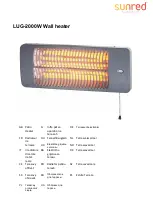
pushing through the full length with a fl ue brush.
(c) The fl ue brush should be withdrawn so as to pull any
deposits back into the bottom of the fl ue box where they can
then be removed by using a vacuum cleaner.
(d) Particular attention should be paid to the upper internal
surfaces of the tubes, where through convection heavier
deposition is likely to occur.
(e) Any deposits which may have accumulated within the
combustion chamber can be removed with a vacuum cleaner
once the burner is removed.
Note:
It is most important that a build up of deposits is not allowed
to occur as this can have an adverse eff ect upon the effi
ciency
of the heater and reduce the life of the heat exchanger.
(f) The heat exchanger and combustion chamber should be
visually inspected for signs of splits, cracks, and distortion.
(g) All gaskets should be checked to ensure that they continue
to provide a gas tight seal, if there is an element of doubt then
they should be replaced.
If the condition of the heat exchanger gives cause for concern
the suppliers Service Department should be advised pending
a more detailed examination. Details on rear page
4.2.4 Electrical Supply
All connections must be checked to ensure that they are
secure, and free from corrosion.
Terminals and connections should also be checked to ensure
that no stray strands are bridging terminals.
Electrical continuity should also be checked.
4.2.5 Oil Supply
The oil supply pipe work, tank, and fi ttings should all be
inspected to ensure that they are free from corrosion, and to
ensure that where brackets have been fi tted these remain
secure and off er adequate support.
The oil fi lter should be replaced with a new one, and the
system should be checked for leaks. If the oil level is such to
allow removal of any sludge or other contaminants form the
tank this too should be undertaken, particularly if there have
been problems of poor fi ring associated with contaminants
reaching the burner.
Warning
Any waste oil or sludge must be disposed of correctly. Never
dispose of it by dumping or tipping it down drains or into
watercourses where ground water can become polluted and
environmental damage caused.
4.2.6 Burner
Service requirements for the burner fi tted to the unit heater
are covered in the separate manual prepared by the burner
manufacturer.
Note:
It is most important that the burner is serviced regularly and
in accordance with the manufacturers instructions.
4.2.7 Air Delivery System
A visual inspection should be undertaken to ensure that the
air delivery system is in good order, that it remains adequately
supported and that the various joints are eff ectively sealed.
4.2.8 Report
A full and detailed service report should be prepared, it is
advised that the report is not completed until the heater has
been re-commissioned, where upon the completed report
can then be run through with the user.
4.3
Service Re-commissioning
The heater should be re-commissioned as follows, as per
section 3.1 through to section 3.4 inclusive.
This must be regarded as a necessary part of the heater
service. By the service engineer.
Summary of Contents for OUH 2 100
Page 20: ...Wiring Diagram 33 65 245 Models OUHA OUHC40 ON OFF Riello Oil Fried Burner...
Page 21: ...Wiring Diagram 33 65 246 Models OUHA 60 70 ON OFF Riello Oil Fried Burner...
Page 22: ...Wiring Diagram 73 65 010 Models OUHA 90 100 ON OFF Riello Oil Fried Burner...
Page 23: ...Wiring Diagram 33 65 247 Models OUHC 60 100 ON OFF Riello Oil Fried Burner...
Page 24: ...Wiring Diagram 33 65 248 Models OUHA OUHC 40 HI LOW Riello Oil Fried Burner...
Page 25: ...Wiring Diagram 33 65 249 Models OUHA 60 70 HI LOW Riello Oil Fried Burner...
Page 26: ...Wiring Diagram 73 65 011 Models OUHA 90 100 HI LOW Riello Oil Fried Burner...
Page 27: ...Wiring Diagram 33 65 250 Models OUHC 60 100 HI LOW Riello Oil Fried Burner...
Page 35: ...Turbulator positions in models 40 70 8 off Turbulator positions in models 90 100 12 off...
Page 43: ...Notes...











































